The grass tree is quite a landscape delight. With skirts of grass and trunks that are often blackened by fire, they can look almost cartoon like or even something a bit prehistoric. They certainly catch your eye in any landscape.
In this how to grow and care guide, we’ll look at some grass tree varieties, what the tree needs in terms of soil and sunlight, water and pruning. Check out our section about propagating from seeds, as well as the frequently asked questions.
You might think that a tree this complex looking is not easy to grow and care for, but with a bit of patience, you’ll have a flowering tree worth waiting for.
More...
Family: | Asphodelaceae |
|---|---|
Genus: | Xanthorrhoea |
Common Name: | Grass tree |
Sunlight: | Full sun |
Height: | Reaches up to 6 metres |
Spread: | Reaches up to 2.5 metres |
Soil type: | Moist and well-draining |
Soil pH: | Slightly acidic, neutral, slightly alkaline |
Maintenance level: | Low |
Introducing the Grass Tree
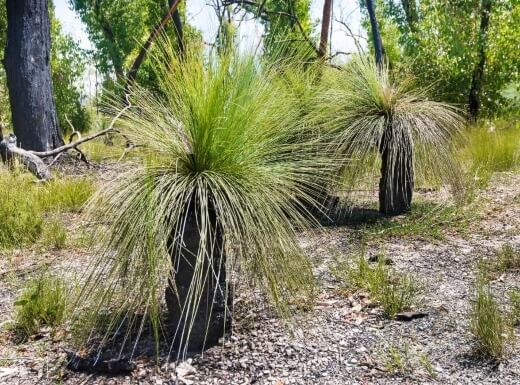
The Grass Tree (Xanthorrhoea) grows incredibly slowly but you know that saying ‘slow and steady wins the race’? This tree might be a slow grower but it can live up to 600 years.
There are many different species – the main difference is whether the trunk is above or below the ground in the case of the shorter ones. They can be as small as 1 metre and as tall as 6 metres.
This is now a protected species in Australia and the established trees produce flowers up to 3 times a year. Birds will come and eat the seeds and flowers, making it the perfect invitation for wildlife.
Xanthorrhoea Growing Habits
Grass tree is low maintenance and is gaining popularity in the everyday garden. The entire 66 species of grass tree are only found in Australia.
These trees grow well in soil without much nutrients and wildfire is no threat to them. They just grow more flowers in response to fire! This is because the part of the tree responsible for growth lives underground.
Want to know when the last fire was in that area? You can look at the length of the skirt or old hanging leaves on a grass tree. The longer the leaves, the longer the time since the last fire.
Grass trees have a root system that works together with microbes in the soil. The microbes actually help the plant or tree to absorb the nutrients it needs.
If you’re waiting for a grass tree to flower, you might be in for a bit of a wait. It sometimes takes a few years before the first flower appears. These are white or yellow and can grow up to 3 metres.
The flower grows on a spike and produces lots of nectar – great news for wildlife. The flowers can produce up to 10 000 seeds! If you’re wondering about the name, grass tree seems apt when you see the grassy leaves that stick out from the base of the tree.
It’s also not like any other tree trunk, but actually layers of old grass leaves that get sandwiched together with the resin from the tree.
Grass Tree Varieties
There are around 30 species of Australian Grass Trees which are part of the Xanthorrhoea genus. We’ll look at a few of the most popular ones below:


Get Your Free Guide:
Master Growing Australian Natives eBook
A Must Have Complete Guide for Every Australian Garden
Get Your Free Guide:
Master Growing Australian Natives eBook
A Must Have Complete Guide for Every Australian Garden
Kangaroo Tail (Xanthorrhoea australis)

Native to South Australia and called the Australian grass tree. Sometimes it’s also called Kangaroo Tail. This is because it has long and thin leaves that can be a metre long. It grows incredibly slowly – two centimetres a year!
Grass Tree (Xanthorrhoea glauca)
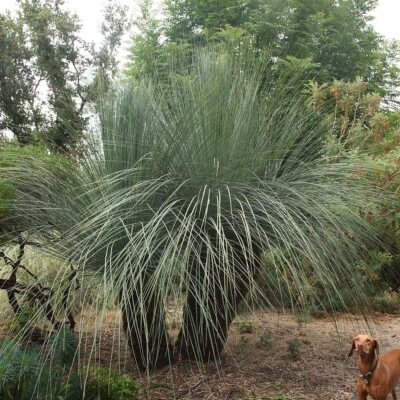
Source: smgrowers.com
Native to eastern Australia and can reach up to 5 metres in height with various branches. It produces lots of small white flowers.
Slender Blackboy (Xanthorrhoea gracilis)
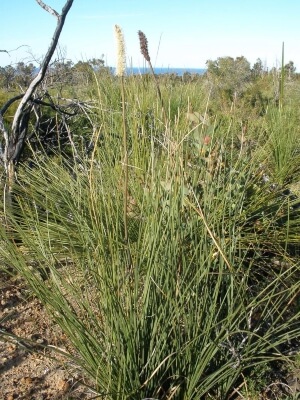
Source: gcln.org.au
Also called the Slender Blackboy, this species is native to West Australia. The stem is underground, with leaves up to 2 metres long and cream coloured flowers.
Johnson's Grass Tree (Xanthorrhoea johnsonii)
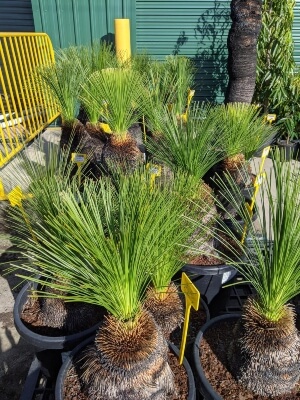
Source: projectplants.com.au
Native to West Australia and is poisonous to cattle who eat the leaves. It looks a bit like a cycad as the bases of the leaves form a trunk.
Bottlebrush Grass Tree (Xanthorrhoea macronema)

Source: apps.lucidcentral.org
Native to Queensland and NSW, has no trunk and has long cream-colored flowers.
Balga (Xanthorrhoea preissii)

Native to West Australia and called the Western Blackboy. This name comes from the trunk that turns black from all the bushfires in the area.
Cundeelee grasstree (Xanthorrhoea thorntonii)
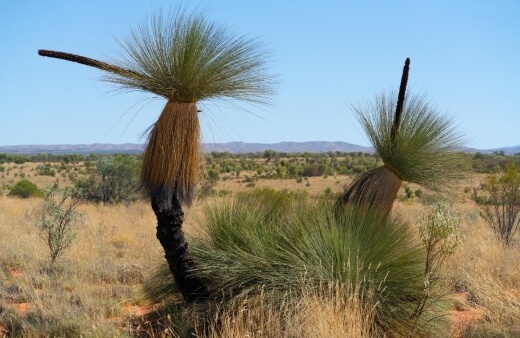
This species is commonly known as Cundeelee Blackboy and native to central Australia. These are the only grass tree species you will find in this area. It can reach a height of up to 5 metres and has a flower over a metre big.
Kangaroo Tail |  |
Grass Tree |  Source: smgrowers.com |
Slender Blackboy |  Source: gcln.org.au |
Johnson's Grass Tree |  Source: projectplants.com.au |
Bottlebrush Grass Tree |  Source: apps.lucidcentral.org |
Balga (Xanthorrhoea preissii)Native to West Australia and called the Western Blackboy. This name comes from the trunk that turns black from all the bushfires in the area. |  |
Cundeelee grasstree |  |
How to Grow Grass Trees
Xanthorrhoea Propagation from Seeds
The good news is that having your very own grass tree is quite a simple process and you can do this from seed. You can plant your grass tree seeds at any time of the year, but to help germination along, spring or autumn are a bit more stable in terms of temperature.
Prep your container with potting mix and sand which helps with drainage. Water the mixture, add the seeds to the soil layer, and then cover them with more soil. You’ll want to cover the container to help maintain the water level.
The container once covered should be placed somewhere warm – an ideal range is 18 to 22 degrees Celsius. If it looks like the soil is drying out, you can spray with water.
You’re looking at about 4 to 6 weeks for germination to happen. In some cases, it takes up to a year. You can let the seed grow until you notice it starts touching the container covering.

Be gentle when taking it out of the container to protect the roots. You’ll move each seedling to its own pot with a well-draining potting mix. They’ll need to stay in the pot for a year in a part shaded area. Remember not to let the soil dry out.
You might notice the roots starting to sneak out the bottom of the pot and once the root ball has developed, you can plant your grass tree in the garden, again aiming for spring or autumn.
Xanthorrhoea don’t like being transplanted so make sure you choose the right spot.
Garden soil can be a tricky business and we know that healthy soil gives your plants the best chance of health and happiness. Have a look at our article about 5 garden soil problems and solutions to help you out.
Grass Tree Care Checklist
Sunlight
Your grass tree will need full sun or part shade in order to grow and thrive.
Watering Needs
You need to water your tree well after planting. Once the tree is established, it doesn’t need as much water. They are quite drought tolerant. Ultimately, you want to find the right balance as the tree will always do better with regular water but you don’t want to overwater.
As a guideline, twice a week is plenty in the dry summer. Here’s another important tip – the actual trunk of the tree and the leaves need to remain dry.
You want to water the soil around it and not the actual parts of the tree, otherwise you might end up with unwanted disease.
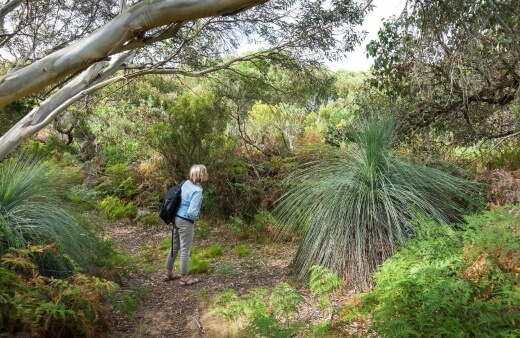
Best Soil for Xanthorrhoea
Xanthorrhoea needs moist and well-drained soil that is sandy or loamy. In terms of pH, mildly acidic, neutral and mildly alkaline all work.
Pruning Grass Trees
The first sign that you need to prune your grass tree is that it’s turning brown. Without cutting the leaves, it can’t regrow. It’s easier if you tie the leaves together with string so you can get to the roots.
Use sharp scissors or secateurs (see our review of top rated secateurs for 2023) and make sure the cut is straight and even. Cut off the brown parts from the tree bottom to allow it to grow new leaves and stems. Try and make sure your cut is as even as possible.
When you untie the string, just check again for any brown leaves and remove where necessary. Anything that’s brown has to go.
Fertilising Grass Trees
The best thing you can do for your grass tree is to help the root system. Add a liquid seaweed fertiliser for a few months after you’ve planted it.
Here’s a little secret from the experts – adding brown sugar and water solution to the soil feeds the fungi in the soil which helps the root system access nutrients.
Pests and Diseases that May Affect the Grass Tree
The Grass Tree is quite resilient when it comes to pests and diseases. You might end up dealing with scale (a white insect). You can use something like neem oil to spray the areas of the plant under attack and a weekly coating should do the trick.
Phytophthora Cinnamomi
Xanthorrhoea can also suffer from phytophthora cinnamomi. This is a type of mould that affects the root system of the tree and can cause it to rot. A fungicide like potassium phosphite is a common treatment but it doesn’t cure the mould.
It just helps contain the spread and further damage to the tree. You should also remove the parts of the tree that are visibly affected by the disease.
It’s always a good idea to dispose of these infected parts safely, either by burning or taking them out of the garden, to prevent any risk of them infecting and affecting other plants or parts of your garden.
Be sure to sterilise and thoroughly clean any tools that you were using for the pruning process.
Grass Tree Frequently Asked Questions
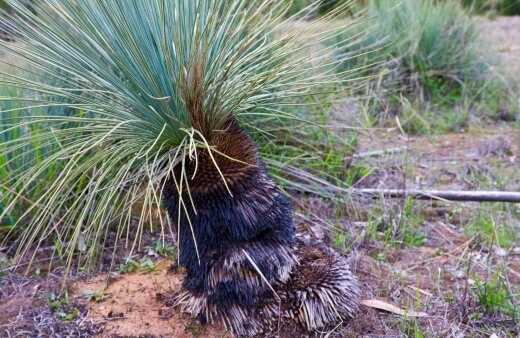
What does the botanical name for the grass tree mean?
Xanthorrhoea is from the Greek word xanthos, meaning ‘to flow’ and relates to the resin that flows from the stem.
Does the grass tree have significance to the Aboriginal people of Australia?
Yes absolutely. They use the resin as glue to make spears. The flower spikes are used for fishing and fire sticks and seed pods as cutting instruments. They also use the nectar from the flower to make a sweet drink.
What else do people call the grass tree?
They are also called 'yacca'. This comes from a South Australian Aboriginal language, called Kaurna. The Aboriginal name for the tree is ‘balga’ or black boy. This describes the black trunk of the tree after a fire season.
Are there any particular species of grass tree that are very rare?
In Victoria, the Grey Grass Tree (Xanthorrhoea glauca subsp. angustifolia) is a threatened species under the Flora and Fauna Guarantee Act.
How easy is it to replant a grass tree?
If a grass tree has an established root system you’ll be more successful in transplanting it. It will need lots of water after replanting for at least 2 years. You can replant it with the same soil it was in and then give it a native fertiliser every 6 to 12 months.
Choosing the right fertiliser is so important but not all fertilisers are made equal. Before you go shopping, have a look at our fertiliser buying guide and product reviews to help you make the best choice.
Sign up for our AGT newsletter for more gardening tips and inspiration.
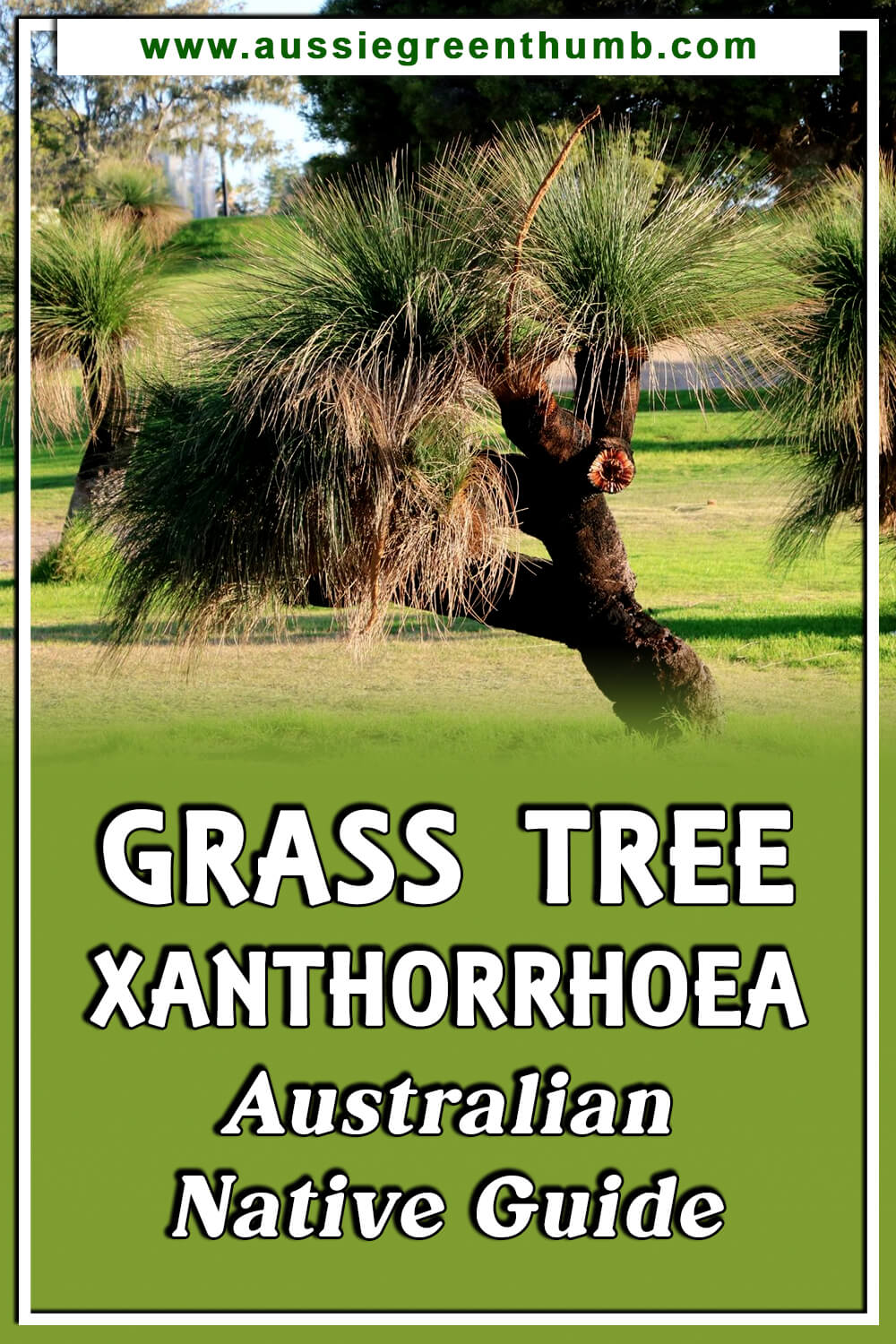
Wrapping Up Our Grass Trees Guide
The Australian landscape is made more interesting, and certainly more beautiful, with the grass tree and its varieties. This tree even feels a bit inspirational – when put under fire, it stands strong and just produces more flowers.
Xanthorrhoea has a long and interesting history, starting with the Aboriginal people who found it incredibly useful, and is now in some parts a protected species.
To think that one flower can produce up to 10 000 seeds is remarkable, and how the birds and insects love to feed on this tree and its offerings. The grass tree is worth the wait if you’re planning to grow your own, and you might end up with a tree that sees quite a few generations after you.
The grass tree feels very proudly Australian and we’re giving it our green thumbs up.
Published on July 26, 2022 by Lorri Hopkins
Last Updated on January 25, 2025




